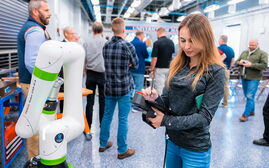Fitbit for lobsters? UMaine tracker could improve lobster survival in supply chain
Miniature fitness trackers for lobsters and devices to monitor the quality of their shipping conditions are being prototyped as part of an initiative to improve the survival of Maine's catch as it goes through the supply chain.
The University of Maine Lobster Institute leads the initiative.
“Maine’s lobster industry asked the institute to help quantify and mitigate stress points in the lobster supply chain that reduce survival and profitability,” the Lobster Institute’s director, Rick Wahle, who is based at UMaine’s Darling Marine Center, said in a news release.
“The industry calls it ‘shrink’ — the mortality lobsters experience as they change hands from capture to kitchen. It’s been a longstanding, contentious issue that is heating up, both literally and figuratively, in a changing climate and competitive world market.”
The Maine Lobster Dealers’ Association and the Maine Lobstermen’s Association have been the driving forces in the project. The Lobster Institute is working with lobster industry partners and scientific collaborators at Saint Joseph’s College in Standish and Wells National Estuarine Research Reserve.
The effort was one of 30 projects nationwide to receive funding earlier this year from the National Oceanographic and Atmospheric Administration Saltonstall-Kennedy Program.
The two-year project received more than $299,000.
C-HAT and MockLobster
Miniature sensory devices — crustacean heart and activity trackers (C-HAT, pronounced sea-hat) — are being prototyped. Comparable to a human fitness tracker, the noninvasive device strapped on a lobster is designed to monitor heart rate and movement as the crustacean passes from trap to on-board live tank to live storage crate to truck to wholesaler or processor.
A separate sensor-equipped device called the MockLobster will also travel along with crated lobsters to log environmental conditions experienced, including temperature, light and dissolved oxygen.
“The idea is to strap the C-HAT on a lobster in a crate as a representative of how a lobster responds to the trip from boat to wharf to wholesaler and to its final destination,” said Ben Gutzler of Wells National Estuarine Research Reserve. “Ideally, we will also have a MockLobster traveling with the C-HAT to measure temperature, motion and other conditions, as the crate makes the trip.
"We’ll then do it all over again for more trips, so we have a representative sampling of trips from a particular wharf.”
Identify stress points
Meanwhile, UMaine researchers are working with harvesters and dealers to develop an economical, standardized protocol to monitor water quality and the health of lobsters as they move from trap to boat wells to live tanks on wharfs and inland storage facilities.
"This project is the first comprehensive industry-science collaboration to look at the way our industry does business and asks the question: How can we do things better?" said Curt Brown of Ready Seafood in Portland and Saco. "Small improvements in holding and handling practices can potentially lead to big improvements in the bottom lines of everyone along the supply chain."
By developing and implementing quality-control mechanisms, and defining best practices, the researchers and industry leaders hope to address the longstanding problem of mortality in the lobster supply chain. Shrink is becoming an even greater concern with the large volume of lobster handled by the fishery, the changing climate and increasingly competitive global markets.
Andrew Goode, a UMaine doctoral student in oceanography and a lobsterman from Boothbay, and Cassie Leeman, a master’s student in marine biology, have been undertaking the initial setup for monitoring, data collection and analysis in collaboration with working supply chain companies, such as Ready Seafood and Luke’s Lobster, both members of the Maine Lobster Dealers’ Association. The initial work was catalyzed by a one-year, $35,000 2019 Graduate Assistantship Award to Goode from the University of Maine System Research Reinvestment Fund.
From trap to dealer
The project aims to track both conditions and lobster health through the supply chain. Goode’s and Leeman’s academic adviser, Damian Brady, UMaine assistant professor of marine sciences who also is based at the Darling Marine Center, is a co-investigator on the project; his focus is on monitoring and mitigating the conditions that lobster experience as they move from trap to dealer.
At the same time, co-investigator Deborah Bouchard, UMaine Aquaculture Research Institute director, is leading the development of protocols to monitor lobster health along the way, including behavior, blood proteins, and other physiological indicators.
“We are making a collective effort to bring new technology to bear to address stress points as lobsters change hands multiple times in their trip from trap to table,” said Wahle. “If we can demonstrate that we have the tools to track the fate of lobsters through the supply chain and enhance their survival, that will be a success.”
The goal is to improve handling practices to minimize waste and make more efficient use of the natural resource.













0 Comments